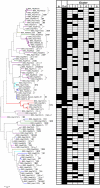What causes mating system shifts in plants? Arabidopsis lyrata as a case study
- PMID: 27804968
- PMCID: PMC5176122
- DOI: 10.1038/hdy.2016.99
What causes mating system shifts in plants? Arabidopsis lyrata as a case study
Erratum in
-
What causes mating system shifts in plants? Arabidopsis lyrata as a case study.Heredity (Edinb). 2017 Jan;118(1):110. doi: 10.1038/hdy.2016.122. Epub 2016 Dec 7. Heredity (Edinb). 2017. PMID: 27925617 Free PMC article. No abstract available.
Abstract
The genetic breakdown of self-incompatibility (SI) and subsequent mating system shifts to inbreeding has intrigued evolutionary geneticists for decades. Most of our knowledge is derived from interspecific comparisons between inbreeding species and their outcrossing relatives, where inferences may be confounded by secondary mutations that arose after the initial loss of SI. Here, we study an intraspecific breakdown of SI and its consequences in North American Arabidopsis lyrata to test whether: (1) particular S-locus haplotypes are associated with the loss of SI and/or the shift to inbreeding; (2) a population bottleneck may have played a role in driving the transition to inbreeding; and (3) the mutation(s) underlying the loss of SI are likely to have occurred at the S-locus. Combining multiple approaches for genotyping, we found that outcrossing populations on average harbour 5 to 9 S-locus receptor kinase (SRK) alleles, but only two, S1 and S19, are shared by most inbreeding populations. Self-compatibility (SC) behaved genetically as a recessive trait, as expected from a loss-of-function mutation. Bulked segregant analysis in SC × SI F2 individuals using deep sequencing confirmed that all SC plants were S1 homozygotes but not all S1 homozygotes were SC. This was also revealed in population surveys, where only a few S1 homozygotes were SC. Together with crossing data, this suggests that there is a recessive factor that causes SC that is physically unlinked to the S-locus. Overall, our results emphasise the value of combining classical genetics with advanced sequencing approaches to resolve long outstanding questions in evolutionary biology.
Figures


Similar articles
-
Breakdown of self-incompatibility in the perennial Arabidopsis lyrata (Brassicaceae) and its genetic consequences.Evolution. 2005 Jul;59(7):1437-48. Evolution. 2005. PMID: 16153030
-
Molecular characterization and evolution of self-incompatibility genes in Arabidopsis thaliana: the case of the Sc haplotype.Genetics. 2013 Mar;193(3):985-94. doi: 10.1534/genetics.112.146787. Epub 2013 Jan 10. Genetics. 2013. PMID: 23307897 Free PMC article.
-
Recent loss of self-incompatibility by degradation of the male component in allotetraploid Arabidopsis kamchatica.PLoS Genet. 2012;8(7):e1002838. doi: 10.1371/journal.pgen.1002838. Epub 2012 Jul 26. PLoS Genet. 2012. PMID: 22844253 Free PMC article.
-
A transgenic self-incompatible Arabidopsis thaliana model for evolutionary and mechanistic studies of crucifer self-incompatibility.J Exp Bot. 2010 Apr;61(7):1897-906. doi: 10.1093/jxb/erp393. Epub 2010 Jan 22. J Exp Bot. 2010. PMID: 20097845 Review.
-
Genetic causes and consequences of the breakdown of self-incompatibility: case studies in the Brassicaceae.Genet Res (Camb). 2008 Feb;90(1):47-60. doi: 10.1017/S0016672307008907. Genet Res (Camb). 2008. PMID: 18289400 Review.
Cited by
-
Characterization and practical use of self-compatibility in outcrossing grass species.Ann Bot. 2021 Jun 24;127(7):841-852. doi: 10.1093/aob/mcab043. Ann Bot. 2021. PMID: 33755100 Free PMC article. Review.
-
Genomic regulation of plant mating systems: flexibility and adaptative potential. A commentary on: 'A new genetic locus for self-compatibility in the outcrossing grass species perennial ryegrass (Lolium perenne)'.Ann Bot. 2021 May 7;127(6):iv-vi. doi: 10.1093/aob/mcab024. Ann Bot. 2021. PMID: 33754631 Free PMC article.
-
Investigations into a putative role for the novel BRASSIKIN pseudokinases in compatible pollen-stigma interactions in Arabidopsis thaliana.BMC Plant Biol. 2019 Dec 11;19(1):549. doi: 10.1186/s12870-019-2160-9. BMC Plant Biol. 2019. PMID: 31829135 Free PMC article.
-
Population Genomics of Transitions to Selfing in Brassicaceae Model Systems.Methods Mol Biol. 2020;2090:269-287. doi: 10.1007/978-1-0716-0199-0_11. Methods Mol Biol. 2020. PMID: 31975171
-
Breakdown of self-incompatibility due to genetic interaction between a specific S-allele and an unlinked modifier.Nat Commun. 2023 Jun 9;14(1):3420. doi: 10.1038/s41467-023-38802-0. Nat Commun. 2023. PMID: 37296115 Free PMC article.
References
-
- Austin RS, Vidaurre D, Stamatiou G, Breit R, Provart NJ, Bonetta D et al. (2011). Next-generation mapping of Arabidopsis genes. Plant J 67: 715–725. - PubMed
-
- Baker HG. (1955). Self-compatibility and establishment after ‘long-distance' dispersal. Evolution 9: 347–349.
-
- Bateman AJ. (1952). Self-incompatibility systems in angiosperms. I. Theory. Heredity 6: 285–310.
-
- Bechsgaard J, Bataillon T, Schierup MH. (2004). Uneven segregation of sporophytic self-incompatibility alleles in Arabidopsis lyrata. J Evol Biol 17: 554–561. - PubMed
-
- Byers DL, Meagher TR. (1992). Mate availability in small populations of plant species with homomorphic sporophytic self-incompatibility. Heredity 68: 353–359.
Publication types
MeSH terms
Substances
Grants and funding
LinkOut - more resources
Full Text Sources
Other Literature Sources
Research Materials
Miscellaneous

